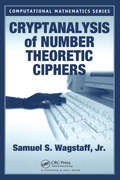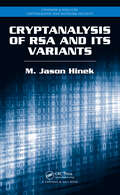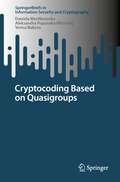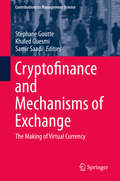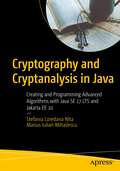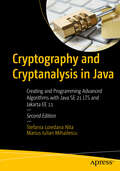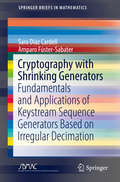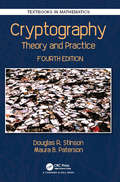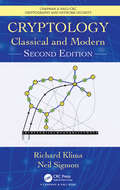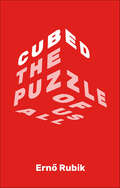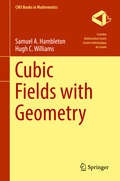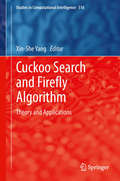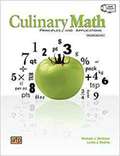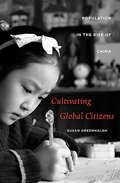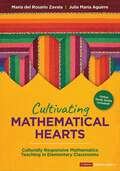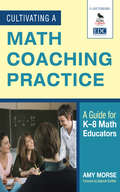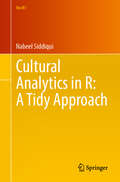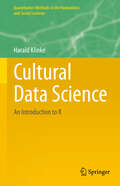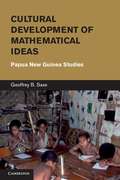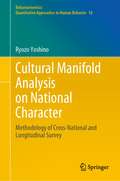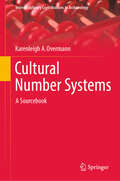- Table View
- List View
Cryptanalysis of Number Theoretic Ciphers (Computational Mathematics)
by Samuel S. Wagstaff, Jr.At the heart of modern cryptographic algorithms lies computational number theory. Whether you're encrypting or decrypting ciphers, a solid background in number theory is essential for success. Written by a number theorist and practicing cryptographer, Cryptanalysis of Number Theoretic Ciphers takes you from basic number theory to the inner workings of ciphers and protocols.First, the book provides the mathematical background needed in cryptography as well as definitions and simple examples from cryptography. It includes summaries of elementary number theory and group theory, as well as common methods of finding or constructing large random primes, factoring large integers, and computing discrete logarithms. Next, it describes a selection of cryptographic algorithms, most of which use number theory. Finally, the book presents methods of attack on the cryptographic algorithms and assesses their effectiveness. For each attack method the author lists the systems it applies to and tells how they may be broken with it.Computational number theorists are some of the most successful cryptanalysts against public key systems. Cryptanalysis of Number Theoretic Ciphers builds a solid foundation in number theory and shows you how to apply it not only when breaking ciphers, but also when designing ones that are difficult to break.
Cryptanalysis of RSA and Its Variants (Chapman & Hall/CRC Cryptography and Network Security Series)
by M. Jason HinekThirty years after RSA was first publicized, it remains an active research area. Although several good surveys exist, they are either slightly outdated or only focus on one type of attack. Offering an updated look at this field, Cryptanalysis of RSA and Its Variants presents the best known mathematical attacks on RSA and its main variants, includin
Cryptocoding Based on Quasigroups (SpringerBriefs in Information Security and Cryptography)
by Verica Bakeva Daniela Mechkaroska Aleksandra Popovska-MitrovikjThis book presents the concept of cryptcoding which arises from the need to obtain secure and accurate transmission. Therefore, it is necessary to improve constantly existing and develop new algorithms that will ensure accurate and secure data transfer. This leads to the intensive development of coding theory and cryptography as scientific fields which solve these problems. To ensure efficient and secure data transmission at the same time, the concept of cryptcoding is developed such that the coding and encryption processes are merged into one process. Cryptcodes provide correction of a certain number of errors in the transmitted message and data confidentiality, using only one algorithm. The main research in this field is to define new algorithms for coding that detects and corrects errors, random codes, stream ciphers, block ciphers, pseudo-random generators, hash functions, etc. This monograph examines an application of quasigroups for designing error-correcting cryptcodes, called Random Codes Based on Quasigroups (RCBQ ). These codes are a combination of cryptographic algorithms and error-correcting codes and depend on several parameters. Some modifications (new coding/decoding algorithms) of RCBQ for improving their performances for transmission ordinary messages, images, and audio files trough a binary-symmetric channel, Gaussian channel, and burst channels are considered. Also, authors propose and analyze filter for visually enhance of the decoded images and improving the quality of decoded audio files.
Cryptofinance and Mechanisms of Exchange: The Making of Virtual Currency (Contributions to Management Science)
by Stéphane Goutte Khaled Guesmi Samir SaadiThis book describes how the rapid advancement in encryption and network computing gave birth to new tools and products that have influenced the local and global economy alike. One recent and notable example is the emergence of virtual currencies (such as Bitcoin) also known as cryptocurrencies. Virtual currencies introduced a fundamental transformation that affected the way goods, services and assets are exchanged. As a result of its distributed ledgers based on blockchain, cryptocurrencies not only offer some unique advantages to the economy, investors, and consumers, but also pose considerable risks to users and challenges for regulators when fitting the new technology into the old legal framework. The core of this proposed book is to present and discuss the evidence on financial asset capabilities of virtual currencies. The contributors of this volume analyze several interesting and timely issues such as the particularities of virtual currencies and their statistical characteristics; the diversification benefits of virtual currencies; the behavior and dependence structure between virtual currencies and the financial markets; the economic implications of virtual currencies, their effects, their price risk, and contagion spillovers in a unified and comprehensive framework; the future of virtual currencies and their distributed ledgers technology.
Cryptography and Cryptanalysis in Java: Creating and Programming Advanced Algorithms with Java SE 17 LTS and Jakarta EE 10
by Stefania Loredana Nita Marius Iulian MihailescuHere is your in-depth guide to cryptography and cryptanalysis in Java. This book includes challenging cryptographic solutions that are implemented in Java 17 and Jakarta EE 10. It provides a robust introduction to Java 17's new features and updates, a roadmap for Jakarta EE 10 security mechanisms, a unique presentation of the "hot points" (advantages and disadvantages) from the Java Cryptography Architecture (JCA), and more. The book dives into the classical simple cryptosystems that form the basis of modern cryptography, with fully working solutions (encryption/decryption operations). Pseudo-random generators are discussed as well as real-life implementations. Hash functions are covered along with practical cryptanalysis methods and attacks, asymmetric and symmetric encryption systems, signature and identification schemes. The book wraps up with a presentation of lattice-based cryptography and the NTRU framework library. Modern encryption schemes for cloud and big data environments (homomorphic encryption and searchable encryption) also are included. After reading and using this book, you will be proficient with crypto algorithms and know how to apply them to problems you may encounter. What You Will Learn Develop programming skills for writing cryptography algorithms in Java Dive into security schemes and modules using Java Explore “good” vs “bad” cryptography based on processing execution times and reliability Play with pseudo-random generators, hash functions, etc. Leverage lattice-based cryptography methods, the NTRU framework library, and more Who This Book Is For Those who want to learn and leverage cryptography and cryptanalysis using Java. Some prior Java and/or algorithm programming exposure is highly recommended.
Cryptography and Cryptanalysis in Java: Creating and Programming Advanced Algorithms with Java SE 21 LTS and Jakarta EE 11
by Stefania Loredana Nita Marius Iulian MihailescuHere is your in-depth guide to cryptography and cryptanalysis in Java. This book includes challenging cryptographic solutions that are implemented in Java 21 and Jakarta EE 11. It provides a robust introduction to Java 21's new features and updates, a roadmap for Jakarta EE 11 security mechanisms, a unique presentation of the "hot points" (advantages and disadvantages) from the Java Cryptography Architecture (JCA), a new chapter on Quantum cryptography, and more. The book dives into the classical simple cryptosystems that form the basis of modern cryptography, with fully working solutions (encryption/decryption operations). Pseudo-random generators are discussed as well as real-life implementations. Hash functions are covered along with practical cryptanalysis methods and attacks, asymmetric and symmetric encryption systems, signature and identification schemes. The book wraps up with a presentation of lattice-based cryptography and the NTRU framework library. Modern encryption schemes for cloud and big data environments (homomorphic encryption and searchable encryption) also are included. After reading and using this book, you will be proficient with crypto algorithms and know how to apply them to problems you may encounter. New to This Edition: The modernized Second Edition is updated to reflect the latest language features in Java 21 and Jakarta 11, along with the introduction of a new chapter on Quantum Cryptography (Chapter 6). What You Will Learn Develop programming skills for writing cryptography algorithms in Java Dive into security schemes and modules using Java Explore “good” vs “bad” cryptography based on processing execution times and reliability Play with pseudo-random generators, hash functions, etc. Leverage lattice-based cryptography methods, the NTRU framework library, and more Who This Book Is For Those who want to learn and leverage cryptography and cryptanalysis using Java. Some prior Java and/or algorithm programming exposure is highly recommended.
Cryptography with Shrinking Generators: Fundamentals and Applications of Keystream Sequence Generators Based on Irregular Decimation (SpringerBriefs in Mathematics)
by Amparo Fúster-Sabater Sara Díaz CardellThis book offers a broad survey of all information made public - from 1993 until today - on keystream sequence generators based on irregular decimation, which are referred to as shrinking generators. Starting with an overview of cryptography, it describes each type of generator - shrinking, self-shrinking, modified self-shrinking, generalized self-shrinking and the DECIM algorithm - with examples and references. Further, the book discusses several attacks on these generators and applications. It concludes by demonstrating how the output sequences can be modeled by means of different families of one-dimensional cellular automata, rendering the generators vulnerable to attacks. Intended for researchers and graduate students, the book will hopefully inspire them to search for more details on this family of generators and to address the open problems in this field.
Cryptography: Theory and Practice (Fourth Edition) (Textbooks in Mathematics #2012)
by Douglas Robert Stinson Maura Paterson<p>Through three editions, Cryptography: Theory and Practice, has been embraced by instructors and students alike. It offers a comprehensive primer for the subject’s fundamentals while presenting the most current advances in cryptography. <p>The authors offer comprehensive, in-depth treatment of the methods and protocols that are vital to safeguarding the seemingly infinite and increasing amount of information circulating around the world.</p>
Cryptology: Classical and Modern (Chapman & Hall/CRC Cryptography and Network Security Series)
by Richard Klima Neil SigmonCryptology: Classical and Modern, Second Edition proficiently introduces readers to the fascinating field of cryptology. The book covers classical methods including substitution, transposition, Playfair, ADFGVX, Alberti, Vigenère, and Hill ciphers. It also includes coverage of the Enigma machine, Turing bombe, and Navajo code. Additionally, the book presents modern methods like RSA, ElGamal, and stream ciphers, as well as the Diffie-Hellman key exchange and Advanced Encryption Standard. When possible, the book details methods for breaking both classical and modern methods. <P><P> The new edition expands upon the material from the first edition which was oriented for students in non-technical fields. At the same time, the second edition supplements this material with new content that serves students in more technical fields as well. Thus, the second edition can be fully utilized by both technical and non-technical students at all levels of study. The authors include a wealth of material for a one-semester cryptology course, and research exercises that can be used for supplemental projects. Hints and answers to selected exercises are found at the end of the book.
Cubed: The Puzzle of Us All
by Erno RubikThe first book by the reclusive inventor of the world’s most iconic puzzle THE RUBIK’S CUBE. Erno Rubik inspires us with what he’s learned in a lifetime of creating, curiosity, and discovery.Erno Rubik was a child when he first became obsessed with puzzles of all kinds. “Puzzles,” he writes, “bring out important qualities in each of us: concentration, curiosity, a sense of play, the eagerness to discover a solution.” To Rubik puzzles aren’t just games—they’re creativity machines. He encourages us to embrace our inner curiosity and find the puzzles that surround us in our everyday lives. “If you are determined, you will solve them,” he writes. Rubik’s own puzzle, the Cube, went on to be solved by millions worldwide for over forty years, become one of the bestselling toys of all time, and to be featured as a global symbol of intelligence and ingenuity.In Cubed, Rubik covers more than just his journey to inventing his eponymous cube. He makes a case for always being an amateur—something he has always considered himself to be. He discusses the inevitability of problems during any act of invention. He reveals what it was like to experience the astonishing worldwide success of an object he made purely for his own play. And he offers what he thinks it means to be a true creator (hint: anyone can do it). Steeped in the wisdom and also the humility of a born inventor, Cubed offers a unique look at the imperfect science of creation.
Cubic Fields with Geometry (CMS Books in Mathematics)
by Samuel A. Hambleton Hugh C. WilliamsThe objective of this book is to provide tools for solving problems which involve cubic number fields. Many such problems can be considered geometrically; both in terms of the geometry of numbers and geometry of the associated cubic Diophantine equations that are similar in many ways to the Pell equation. With over 50 geometric diagrams, this book includes illustrations of many of these topics. The book may be thought of as a companion reference for those students of algebraic number theory who wish to find more examples, a collection of recent research results on cubic fields, an easy-to-understand source for learning about Voronoi’s unit algorithm and several classical results which are still relevant to the field, and a book which helps bridge a gap in understanding connections between algebraic geometry and number theory.The exposition includes numerous discussions on calculating with cubic fields including simple continued fractions of cubic irrational numbers, arithmetic using integer matrices, ideal class group computations, lattices over cubic fields, construction of cubic fields with a given discriminant, the search for elements of norm 1 of a cubic field with rational parametrization, and Voronoi's algorithm for finding a system of fundamental units. Throughout, the discussions are framed in terms of a binary cubic form that may be used to describe a given cubic field. This unifies the chapters of this book despite the diversity of their number theoretic topics.
Cubical Homotopy Theory
by Brian A. Munson Ismar VolićGraduate students and researchers alike will benefit from this treatment of classical and modern topics in homotopy theory of topological spaces with an emphasis on cubical diagrams. The book contains 300 examples and provides detailed explanations of many fundamental results. Part I focuses on foundational material on homotopy theory, viewed through the lens of cubical diagrams: fibrations and cofibrations, homotopy pullbacks and pushouts, and the Blakers–Massey Theorem. Part II includes a brief example-driven introduction to categories, limits and colimits, an accessible account of homotopy limits and colimits of diagrams of spaces, and a treatment of cosimplicial spaces. The book finishes with applications to some exciting new topics that use cubical diagrams: an overview of two versions of calculus of functors and an account of recent developments in the study of the topology of spaces of knots.
Cuckoo Search and Firefly Algorithm: Theory and Applications (Studies in Computational Intelligence #516)
by Xin-She YangNature-inspired algorithms such as cuckoo search and firefly algorithm have become popular and widely used in recent years in many applications. These algorithms are flexible, efficient and easy to implement. New progress has been made in the last few years, and it is timely to summarize the latest developments of cuckoo search and firefly algorithm and their diverse applications. This book will review both theoretical studies and applications with detailed algorithm analysis, implementation and case studies so that readers can benefit most from this book. Application topics are contributed by many leading experts in the field. Topics include cuckoo search, firefly algorithm, algorithm analysis, feature selection, image processing, travelling salesman problem, neural network, GPU optimization, scheduling, queuing, multi-objective manufacturing optimization, semantic web service, shape optimization, and others. This book can serve as an ideal reference for both graduates and researchers in computer science, evolutionary computing, machine learning, computational intelligence, and optimization, as well as engineers in business intelligence, knowledge management and information technology.
Cuenta de Ratón
by F. Isabel Campoy Ellen Stoll WalshEs una aventura de contar en esta edición en español de ratón Conde. Una serpiente hambrienta se fuera en busca de su cena, y los ratones temerario debe hacer su escape como el recuento de los lectores de UNO de Diez - y de vuelta otra vez!
Culinary Math (Math 24/7 #10)
by Helen ThompsonCooking is a kind of science--you have to get the measurements right to make everything work. It takes math. In Culinary Math, you'll discover how numbers, ratios, and other math help make tasty foods you can cook yourself.
Culinary Math: Principles And Applications
by Michael J. Mcgreal Linda J. PadillaCulinary Math Principles and Applications" demonstrates how and why foodservice workers use math in the professional kitchen. This popular text-workbook helps learners grasp culinary math principles and applications through an engaging and well-illustrated style. Interactive learner resources provide opportunities for reinforcement and further examples of math used in culinary settings. This educational resource can serve as a basis for college culinary math, foodservice math, and hospitality math courses.
Cultivating Global Citizens: Population in the Rise of China (Cultivating global citizens. The Edwin O. Reischauer Lectures, 2008.)
by Susan GreenhalghCurrent accounts of China’s global rise emphasize economics and politics, largely neglecting the cultivation of China’s people. Susan Greenhalgh, one of the foremost authorities on China’s one-child policy, places the governance of population squarely at the heart of China’s ascent. Focusing on the decade since 2000, and especially 2004–09, she argues that the vital politics of population has been central to the globalizing agenda of the reform state. By helping transform China’s rural masses into modern workers and citizens, by working to strengthen, techno-scientize, and legitimize the PRC regime, and by boosting China’s economic development and comprehensive national power, the governance of the population has been critically important to the rise of global China. After decades of viewing population as a hindrance to modernization, China’s leaders are now equating it with human capital and redefining it as a positive factor in the nation’s transition to a knowledge-based economy. In encouraging “human development,” the regime is trying to induce people to become self-governing, self-enterprising persons who will advance their own health, education, and welfare for the benefit of the nation. From an object of coercive restriction by the state, population is being refigured as a field of self-cultivation by China’s people themselves.
Cultivating Mathematical Hearts: Culturally Responsive Mathematics Teaching in Elementary Classrooms (Corwin Mathematics Series)
by Maria del Zavala Julia Maria AguirreHelp students see their whole selves in the math they′re learning with culturally responsive teaching. Cultivating Mathematical Hearts: Culturally Responsive Mathematics Teaching in Elementary Classrooms, aims to re-center mathematics as a humanizing endeavor because putting children and their humanity at the heart of mathematics education can result in more engaged, meaningful, and joyful learning. This book introduces a model and a tool for Culturally Responsive Mathematics Teaching, constructed to create a safe, inclusive space where all learners can come together in their own educational journey and develop a love for math that centers their experiences and comes from the heart. Implementing the Culturally Responsive Mathematics Teaching Tool (CRMT2) will help you cultivate and sustain meaningful, rich, and rigorous mathematical learning spaces for all your students–experiences that foster mathematical curiosity and joy. The book walks you through each aspect of the framework and tool, guiding you to consider how your classroom structures, lessons, tasks, and assessments: Honor the existing cultural strengths, experiences, and lived realities of all your students Elicit diverse mathematical thinking and ideas Support equitable access to rigorous mathematical learning and discourse for all students Invite a sense of agency in each student’s learning experience Promote high engagement and excitement while learning mathematics Nurture an understanding that mathematics is a powerful tool for making sense of the world By weaving these strategies into classroom lessons, teachers can humanize mathematics instruction to successfully build a love for math while providing equitable learning opportunities that empower student voice and promote success in mathematics.
Cultivating Mathematical Hearts: Culturally Responsive Mathematics Teaching in Elementary Classrooms (Corwin Mathematics Series)
by Maria del Zavala Julia Maria AguirreHelp students see their whole selves in the math they′re learning with culturally responsive teaching. Cultivating Mathematical Hearts: Culturally Responsive Mathematics Teaching in Elementary Classrooms, aims to re-center mathematics as a humanizing endeavor because putting children and their humanity at the heart of mathematics education can result in more engaged, meaningful, and joyful learning. This book introduces a model and a tool for Culturally Responsive Mathematics Teaching, constructed to create a safe, inclusive space where all learners can come together in their own educational journey and develop a love for math that centers their experiences and comes from the heart. Implementing the Culturally Responsive Mathematics Teaching Tool (CRMT2) will help you cultivate and sustain meaningful, rich, and rigorous mathematical learning spaces for all your students–experiences that foster mathematical curiosity and joy. The book walks you through each aspect of the framework and tool, guiding you to consider how your classroom structures, lessons, tasks, and assessments: Honor the existing cultural strengths, experiences, and lived realities of all your students Elicit diverse mathematical thinking and ideas Support equitable access to rigorous mathematical learning and discourse for all students Invite a sense of agency in each student’s learning experience Promote high engagement and excitement while learning mathematics Nurture an understanding that mathematics is a powerful tool for making sense of the world By weaving these strategies into classroom lessons, teachers can humanize mathematics instruction to successfully build a love for math while providing equitable learning opportunities that empower student voice and promote success in mathematics.
Cultivating a Math Coaching Practice: A Guide for K-8 Math Educators
by Amy MorseThis resource offers math activities, planning activities, and a facilitator's guide for developing mathematics leaders' coaching practice and knowledge of math teaching and learning.
Cultural Analytics in R: A Tidy Approach (Use R!)
by Nabeel SiddiquiThis book offers an introduction to computational analysis for humanities scholars and researchers, systematically bridging traditional inquiry with the data-intensive capabilities of the R programming language. Employing diverse cultural datasets about gaming, film, literature, and music, it emphasizes the need to structure data, particularly through the &‘tidy data&’ paradigm, as a foundational practice for efficient analysis. Beginning with the fundamentals of R, the book progresses through sophisticated analytical techniques, including text mining, sentiment analysis, network analysis, and machine learning, all contextualized with rich cultural examples. In doing so, it demystifies complex computational procedures, empowering readers to apply these tools to critical cultural research and fostering a new generation of data-literate humanists equipped to navigate and interpret the increasingly digital cultural record.
Cultural Data Science: An Introduction to R (Quantitative Methods in the Humanities and Social Sciences)
by Harald KlinkeThis book addresses growing demand in the visual humanities for foundational knowledge in data analysis, image processing, and artificial intelligence. Intended for readers without prior technical knowledge, its eighteen chapters introduce key concepts in data science through examples from art history, visual computing, and cloud technologies. For advanced readers, it explores how digital methods enhance our understanding of our cultural past. Focusing on image-based humanities research, the book demonstrates practical applications using open source software such as R, RStudio, and ImageMagick, along with open data sets from institutions like the MoMA, the Met, and the Rijksmuseum. Ideal for students, researchers, and professionals in art history, digital humanities, and museum studies, this book bridges the gap between technology and the humanities, making complex digital methods accessible to a broad audience.
Cultural Development of Mathematical Ideas
by Geoffrey B. Saxe Indigo EsmondeDrawing upon field studies conducted in 1978, 1980, and 2001 with the Oksapmin, a remote Papua New Guinea group, Geoffrey B. Saxe traces the emergence of new forms of numerical representations and ideas in the social history of the community. In traditional life, the Oksapmin used a counting system that makes use of twenty-seven parts of the body; there is no evidence that the group used arithmetic in prehistory. As practices of economic exchange and schooling have shifted, children and adults unwittingly reproduced and altered the system in order to solve new kinds of numerical and arithmetical problems, a process that has led to new forms of collective representations in the community. While Dr. Saxe's focus is on the Oksapmin, the insights and general framework he provides are useful for understanding shifting representational forms and emerging cognitive functions in any human community.
Cultural Manifold Analysis on National Character: Methodology of Cross-National and Longitudinal Survey (Behaviormetrics: Quantitative Approaches to Human Behavior #10)
by Ryozo YoshinoThis book first presents an overview of the history of a national character survey by the Institute of Statistical Mathematics that has been conducted for more than 65 years. The Japanese National Character Survey, launched in 1953, is a rare longitudinal survey in the world of survey research based on rigorous statistical sampling theory, motivating other countries to launch similar longitudinal surveys, including the General Social Survey (GSS), the Allgemeine Bevölkerungsumfrage der Sozialwissenschaften (ALLBUS, German General Social Survey (GGSS)), Eurobarometer, and others. Since the early 1970s, the Japanese survey has been extended as a cross-national survey for more advanced research of the Japanese national character in a comparative context. Second, the book explains the paradigm of cross-national studies called the Cultural Manifold Analysis (CULMAN), developed in the longitudinal and cross-national surveys, with practical examples of analysis. This explanation will help helps a wide range of readers to better understand the cross-national comparative surveys of attitudes, opinion, and social values as basic information for evidence-based policymaking and research.
Cultural Number Systems: A Sourcebook (Interdisciplinary Contributions to Archaeology)
by Karenleigh A. OvermannThis sourcebook presents an extensive look at cultural number systems in numeracy and writing systems. Based on a decade of research by the author, the work examines topics such as why Xerxes the First counted his army by having his men march through an enclosure big enough to hold 10,000 of them at a time, why the Hawaiian word for "twenty" means “nine and two,” why an ancient Greek mathematician was driven mad by irrational numbers, and how old counting might be and how we might know this. Along the way, the author describes topics such as dactylonomy, the ancient art of expressing and calculating numbers with the fingers; specified counting, the use of different counting sequences to count different types of objects; and the ephemeral abacus, strategies for counting that involve people and goods but not an actual device. The chapters are organized into six geographical areas (the ancient Near East, Africa, Europe, Asia/India, Oceania, and the Americas).
